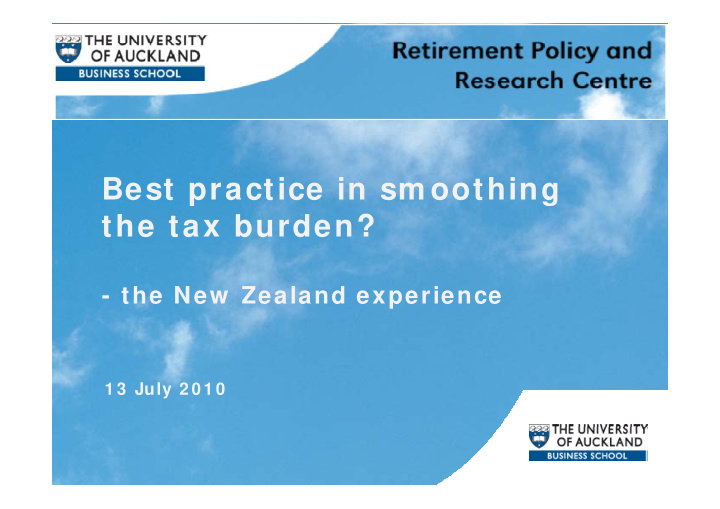



Best practice in sm oothing Best practice in sm oothing the tax burden? - the New Zealand experience 1 3 July 2 0 1 0
Outline Outline • New Zealand pensions landscape • The ‘New Zealand Superannuation Fund’ • but … . • The NZSF in a ‘total accounting context’ • The cost of debt is the ‘hurdle rate’ • Will the NZSF actually help? • A ‘fallacy of composition’?
NZ pensions landscape : Tier 1 pe s o s a dscape e • ‘New Zealand Superannuation’ – Universal (modest residence requirements): no income or asset tests – Taxed as ordinary income Taxed as ordinary income – State Pension Age is 65 – Non-contributory and was purely PAYG – Relatively generous – Linked to average wages – Virtually eliminated age poverty Virtually eliminated age poverty • Current net cost 4% of GDP; 2050 cost: 8% • No Tier 2 (compulsory saving) • No Tier 2 (compulsory saving)
NZ pensions landscape : Tier 3 pe s o s a dscape e 3 • KiwiSaver (since 2007): national, auto- enrolment, opt-out, defined contribution l t t t d fi d t ib ti scheme, tax-subsidised (0.6% of GDP) • All other saving • All other saving – tax neutral (TTE) ‘tax neutral’ (TTE)
New Zealand Superannuation Fund - ‘NZSF’ ‘NZSF’ • Started 2003 • Government contributes more than cost of NZS 2003-2025 and less after 2025 • A ‘smoothed PAYG’ funding basis A ‘ h d PAYG’ f di b i • ‘Arms-length’ Guardians run investments • Traditional approach to strategy • Current assets $15.8 bn (8.3% of GDP) • Projected to grow to 50% of GDP
NZSF: 2 0 0 5 -2 1 0 0 0 0 0 0 5 S
NZSF – projected flow s: 2 0 0 2 -2 0 5 0
I nvestm ent perform ance to 2 0 0 9 est e t pe o a ce to 0 0 9
A fallacy of com position? A fallacy of com position? .............. but is the NZSF
First – the NZSF is losing m oney st t e S s os g o ey • Every dollar in the NZSF is effectively borrowed b d • To 30 June 2009, the NZSF cost taxpayers about $2 4 billion about $2.4 billion • To make investment sense, the NZSF’s return must beat the ‘hurdle rate’ – currently 6 35% must beat the hurdle rate – currently 6.35% • Returns should be higher to compensate for investment risk investment risk • Government’s borrowing to buy financial assets makes little investment sense
W hat m atters w ith ageing populations at atte s t age g popu at o s • Raise future output: – Immigration – Encourage later retirement – Increase State Pension Age – Increase State Pension Age – Increase labour participation at all ages • Restrict working-age consumption Restrict working age consumption • Improve productivity (especially per capita ) • How might the NZSF contribute? How might the NZSF contribute?
Other issues Ot e ssues • PAYG at Tier 1 is more efficient, cheaper, f i fairer and more flexible d fl ibl • Governments should focus on their natural strengths strengths • Current NZSF contribution holiday should be made permanent made permanent • The NZSF: – Avoided an ‘unnecessary’ tax reduction Avoided an unnecessary tax reduction – Does not make NZS more secure – Is an ineffective and potentially expensive distraction – Should be disbanded (with care)
.... in conclusion Please don’t follow the New Z Zealand exam ple l d l
Recommend
More recommend